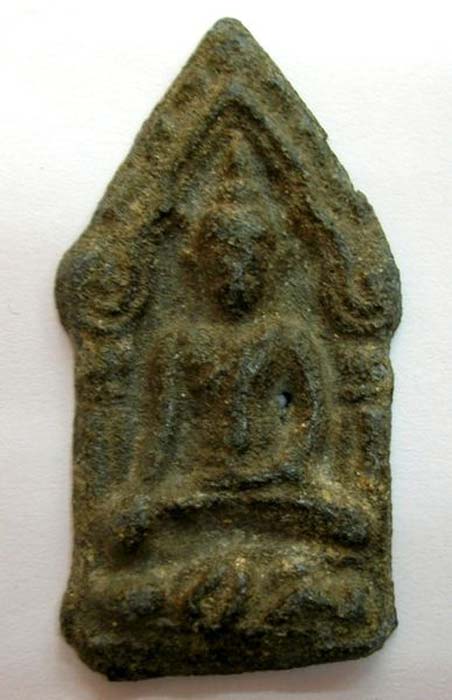
Child Angels, Golden Boys, Supernatural Dolls and Necromancy in Thailand
Recently, reports of a Thai doll craze have been featured at the end of news hours, a spot typically reserved for pop culture tidbits like hijab wearing Barbies (“hijarbies”) or the birthday of the oldest man/woman alive. Yet as kooky as it is to think about people buying additional plane seats for their dolls, this fad is only the latest iteration of a centuries old tradition, one that has a gruesome past.
Luk thep Dolls
Today’s dolls are known as ‘ luk thep,’ which translates as ‘child angels.’ These lifelike looking toys are believed by some to have supernatural powers. They are usually blessed in a ceremony by a Buddhist monk - the same ceremony held for the blessing of amulets (also very popular in Thailand).

Amulet of Khun Phaen. (Public Domain)
It is believed that the doll hosts a wandering spirit who has been invited to reside and animate the doll with a soul. If treated well, the luk thep is said to bring good fortune to its owners. But if ignored or mistreated, the luk thep will act like a naughty child and play tricks. Most importantly, the small angel is supposed to protect its newfound family from any evil spirits that may be lurking about.

Two luk thep dolls. Photo: Facebook/Nongningbowie. (Oddity Central/CC BY NC ND 3.0)
A Child Protector
Superstition and fear of ghosts is very common in Thailand. Before the advent of luk thep, Thais would look to Kuman Thong for protection. The notion of a child protector dates back several centuries to the legend of Khun Chang Khun Phaen, the story of a soldier living in the Ayutthaya era.
In the story, Khun Phaen, a high-ranking soldier, marries the daughter of a powerful sorcerer. Not long into their marriage, Khun Phaen and the sorcerer have a huge fight. Enraged, the sorcerer pressures his daughter into poisoning Khun Phaen. But she cannot go through with it and dies instead. Khun Phaen is so angry that he rips the stillborn fetus from his wife’s womb and casts it into the temple fire. At the end of the ceremony, the child became a ghost that could speak with Khun Phaen and act as a guardian spirit.
- Thai Buddhists observe an ancient tradition of honoring the unclaimed dead
- Malevolent Phantoms, Corpse Brides, and Ancestor Spirits: The Ancient Belief in Ghosts – PART I
- Beware the Supernatural Bathroom Spirits, Toilet Deities, and Dung Demons

Khun Phaen and Wanthong flee to the forest. Mural in sala on Khao Phra, U Thong, Suphanburi, Thailand. (Public Domain)
Thai Necromancy
This tale features elements of Thai necromancy, a black magic practiced by witchdoctors. The ritual of creating a Kuman Thong guardian spirit involves preparing and chanting over the fetus that died while it is still in its mother’s womb. According to ancient manuscripts, the little corpse is to be taken to a cemetery where a fire will have been built up. Before the sun rises, the fetus is placed on a grill over the fire and roasted until dry, while the witch chants incantations to summon Kuman Thong.
Once the dry-roasting is complete, the fetus is painted with a special lacquer known as Ya Lak and then covered in gold leaf. This is the origin of the name Kuman Thong, which means ‘Golden Little Boy’. Ideally, the effigy will also be soaked in Nam Man Phrai, a powerful oil in Thai occult traditions. This is an oil that is derived by placing a candle under the chin of a woman who died while pregnant or a person who died an unnatural or violent death.

A reproduction Kuman Thong sold as a souvenir at the Buddhist temple at Ayutthaya, Thailand, wrapped in a cloth featuring Nang Kwak. (Greg Field/CC BY SA 3.0)
Nam Man Phrai and Kuman Thongs made of dead babies are now illegal. However, every now and again, a story pops up in the news of a cache of dead fetuses detected by airport security guards or smuggled from abortion clinics to be blessed at temples.
- Magnificent Tham Lod Cave Sheds Light on Earliest Humans in Thailand
- Tracing the Origins of the Infamous Ouija Board
- Doppelgangers and the mythology of spirit doubles
Kuman Thong and the Child Angels Today
Today, many Kuman Thong are not made from real human fetuses. Instead, they are small dolls or statues of a little, smiling boy wearing traditional Ayutthaya clothing with his hair in a topknot. He is also often carrying a small bag of gold to bring wealth to his new family.
These Kuman Thong dolls, as well as the related hyper-realistic luk thep dolls, need to be offered food and drink daily. Like most children, they are thought to prefer sweets like cookies and candies. For a drink, the dolls, like many other figures worshipped in Thailand, almost exclusively desire Nam-daeng, which means ‘red water.’ This is made using bright red artificial food coloring and the flavoring of local sala fruit. If traditional Nam-daeng cannot be obtained, red Fanta is the next best thing.
Some believe the idols preference for the red beverage stems from the ancient tradition of offering spirits animal blood. The Kuman Thong and luk thep dolls also need to be regularly shown affection and offered toys, just like a real child would. Otherwise, they have been known to terrorize their neglectful family.

Kuman Thong figures at a shrine in Ratchaburi Province. (Xufanc/CC BY SA 4.0)
Top Image: Kuman Thong amulets. Source: Amazing Thailand
References:
BBC News. "The Privileged Word of Thailand's Supernatural Dolls." BBC News. BBC Corp, 28 Jan. 2016. Web. http://www.bbc.com/news/world-asia-35416537
Lo, Kevin. "Black Magic Baby: The Macabre History of Kuman Thong." Atlas Obscura. Atlas Obscura, 27 Feb. 2014. Web. 03 Sept. 2016. http://www.atlasobscura.com/articles/kuman-thong-roasted-fetuses-in-gold-leaf
Zander, Ryan. "Kuman Thong - Thailand's Golden Ghost Boy." Siam and Beyond. Siam and Beyond, 19 July 2014. Web. http://siamandbeyond.com/kuman-thong-thailand-golden-ghost-boy/















